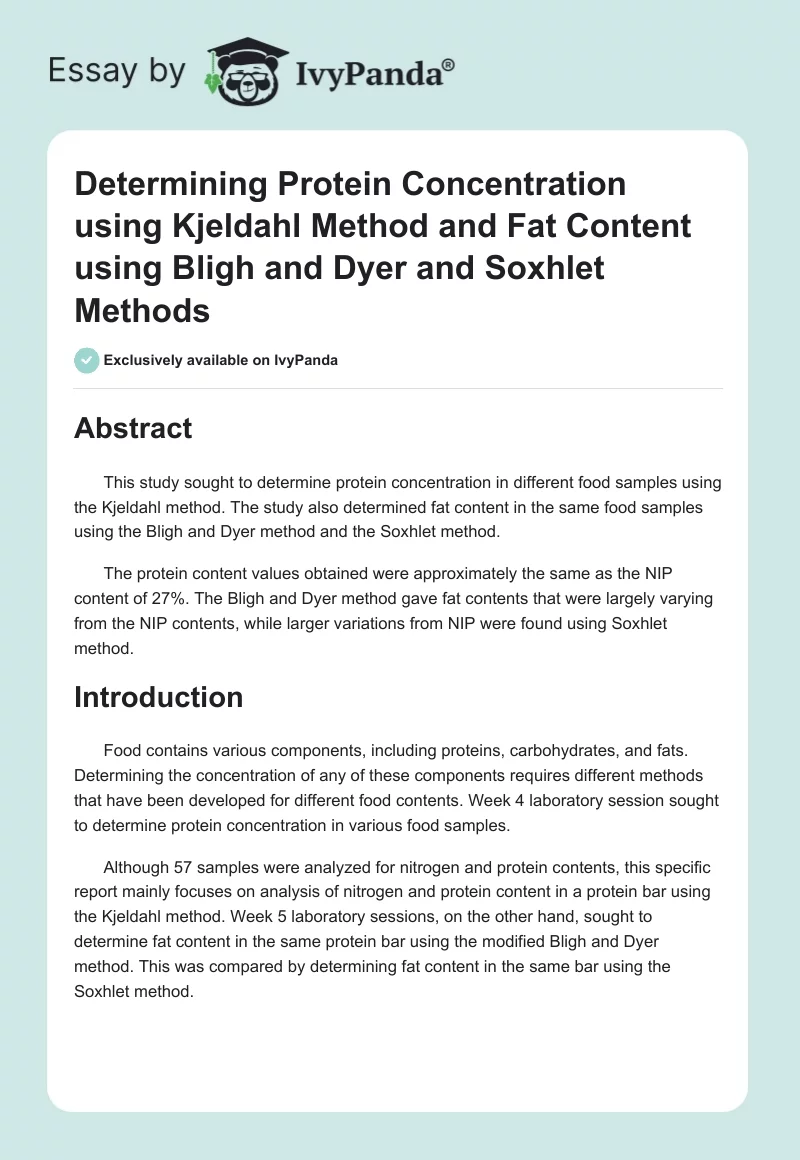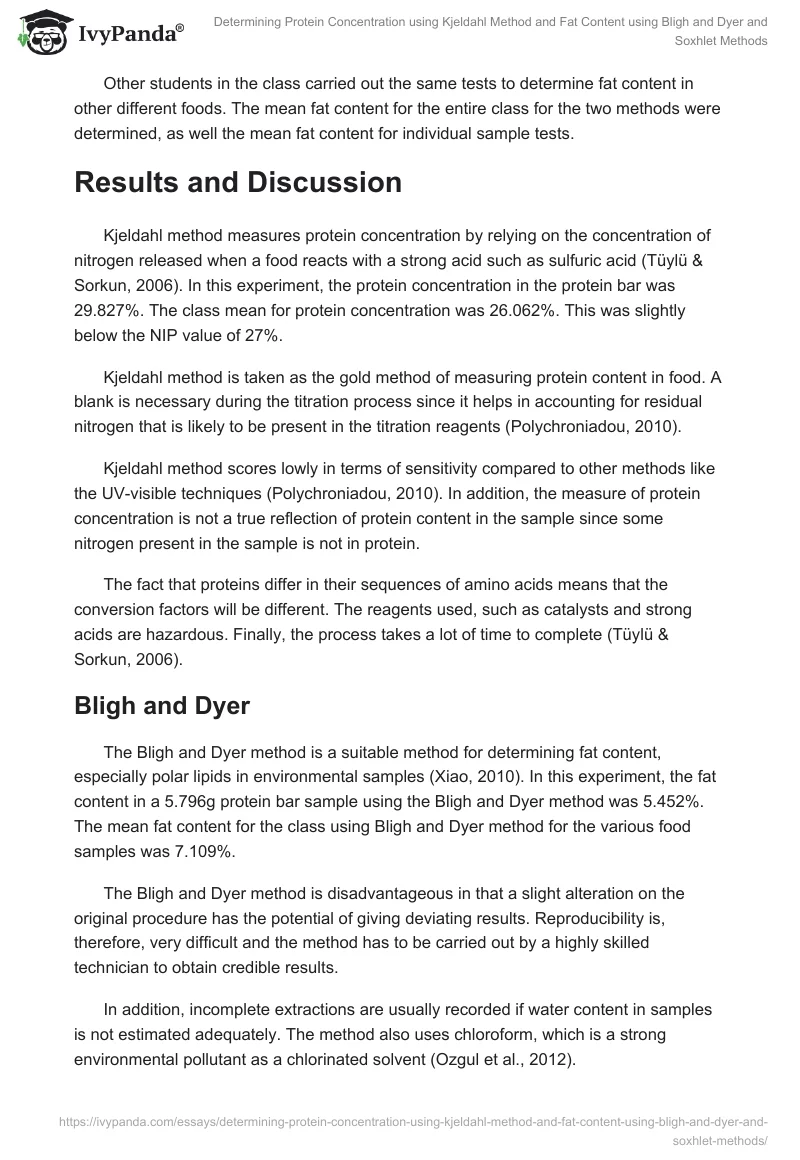Abstract
This study sought to determine protein concentration in different food samples using the Kjeldahl method. The study also determined fat content in the same food samples using the Bligh and Dyer method and the Soxhlet method.
The protein content values obtained were approximately the same as the NIP content of 27%. The Bligh and Dyer method gave fat contents that were largely varying from the NIP contents, while larger variations from NIP were found using Soxhlet method.
Introduction
Food contains various components, including proteins, carbohydrates, and fats. Determining the concentration of any of these components requires different methods that have been developed for different food contents. Week 4 laboratory session sought to determine protein concentration in various food samples.
Although 57 samples were analyzed for nitrogen and protein contents, this specific report mainly focuses on analysis of nitrogen and protein content in a protein bar using the Kjeldahl method. Week 5 laboratory sessions, on the other hand, sought to determine fat content in the same protein bar using the modified Bligh and Dyer method. This was compared by determining fat content in the same bar using the Soxhlet method.
Other students in the class carried out the same tests to determine fat content in other different foods. The mean fat content for the entire class for the two methods were determined, as well the mean fat content for individual sample tests.
Results and Discussion
Kjeldahl method measures protein concentration by relying on the concentration of nitrogen released when a food reacts with a strong acid such as sulfuric acid (Tüylü & Sorkun, 2006). In this experiment, the protein concentration in the protein bar was 29.827%. The class mean for protein concentration was 26.062%. This was slightly below the NIP value of 27%.
Kjeldahl method is taken as the gold method of measuring protein content in food. A blank is necessary during the titration process since it helps in accounting for residual nitrogen that is likely to be present in the titration reagents (Polychroniadou, 2010).
Kjeldahl method scores lowly in terms of sensitivity compared to other methods like the UV-visible techniques (Polychroniadou, 2010). In addition, the measure of protein concentration is not a true reflection of protein content in the sample since some nitrogen present in the sample is not in protein.
The fact that proteins differ in their sequences of amino acids means that the conversion factors will be different. The reagents used, such as catalysts and strong acids are hazardous. Finally, the process takes a lot of time to complete (Tüylü & Sorkun, 2006).
Bligh and Dyer
The Bligh and Dyer method is a suitable method for determining fat content, especially polar lipids in environmental samples (Xiao, 2010). In this experiment, the fat content in a 5.796g protein bar sample using the Bligh and Dyer method was 5.452%. The mean fat content for the class using Bligh and Dyer method for the various food samples was 7.109%.
The Bligh and Dyer method is disadvantageous in that a slight alteration on the original procedure has the potential of giving deviating results. Reproducibility is, therefore, very difficult and the method has to be carried out by a highly skilled technician to obtain credible results.
In addition, incomplete extractions are usually recorded if water content in samples is not estimated adequately. The method also uses chloroform, which is a strong environmental pollutant as a chlorinated solvent (Ozgul et al., 2012).
The Bligh and Dyer method with a low final drying temperature is more suited than the Soxhlet method for production of a lipid sample for the gas chromatography determination of the fatty acid profile. This preference is based on the fact that GC for analyzing fatty acids because it allows for direct methylation of extracted lipids for fatty acid profiling using GC (Xiao, 2010).
Soxhlet method
This is considered to be the standard method of analyzing fats in their crude form (Tomsone, Kruma, & Galoburda, 2012). The mean fat content using Soxhlet method on dry basis for the protein bar was 3.95%, while the fat content was 3.59% on a wet basis. The average fat content for all samples in the class on a dry basis was 12.466%, while the average fat content on a dry basis was 10.481%.
The results for fat content using Soxhlet differed from those obtained using Bligh and Dyer method, whereby the fat content for the sample using Bligh and Dyer method (5.452g%) was higher than the content obtained using Soxhlet method on both dry and wet basis (3.95g% and 3.59g% respectively).
Equally, the average fat content using Bligh and Dyer method was lower (7.109%) compared to the average for dry and wet Soxhlet method (12.466% and 10.48% respectively).
Different results for fat content for some types of foods were obtained using the two methods because Soxhlet method uses apolar solvents, while Bligh and Dyer method uses polar solvents. Moreover, the concentration step in Soxhlet method may have been missed, yet it is necessary in removing excessive solvents (Xiao, 2010).
Majority of the results were higher than the contents indicated on product packaging. This is mainly due to use of different methods in determining fat content. In addition, there might have been a lot of errors introduced during practical classes due to inexperience of the experimenters. This was more likely for the Bligh and Dyer that requires highly skilled technicians (Iverson, Lanf & Cooper, 2001).
Conclusion
The protein content in the protein bar used in the experiment was slightly higher than the NIP content, but the average class protein content was slightly lower than the NIP content. These slight differences could have been caused by procedural errors in the experiment.
The average fat contents using both Bligh and Dyer and Soxhlet methods varied by a great margin from the NIP values. This could have been due to inexperience of experimenters. The entire laboratory session was worthwhile since it provided the opportunity to have hands-on experience in determining protein and fat contents in foods.
Reference List
Iverson, SJ, Lanf, SLC & Cooper, MH 2001, ‘Comparison of the Bligh and Dyer and Folch methods for total lipid determination in a broad range of marine tissue’ Lipids, vol 36, pp. 1283-1287.
Ozgul, Y, Şimşek, A, BalIkçI & Kenar, M 2012, ‘The effects of extraction methods on the contents of fatty acids, especially EPA and DHA in marine lipids’, International Journal of Food Sciences and Nutrition, vol. 63, no. 3, pp. 326-331.
Polychroniadou, A 2010, ‘Interlaboratory collaborative study on the Kjeldahl reference method for nitrogen determination in sheep and goat milk according to ISO 8968-1/2∣IDF 20-1/2’, International Journal of Dairy Technology, vol. 63, no. 3, p. 475-475.
Tomsone, L, Kruma, Z, & Galoburda, R 2012, ‘Comparison of different solvents and extraction methods for isolation of phenolic compounds from horseradish roots (Armoracia rusticana)’, World Academy of Science, Engineering & Technology, 64, pp. 903-908.
Tüylü, A, & Sorkun, K 2006, ‘Protein analysis with Kjeldahl of pollen grains collected by Apis mellifera L’, Mellifera, vol. 6, no. 10-12, pp. 7-11.
Xiao, L 2010, ‘Evaluation of extraction methods for recovery of fatty acids from marine products’, Master thesis of EMQAL project, University of Bergen. Web.


